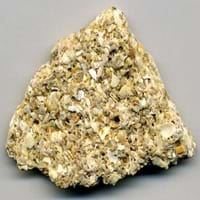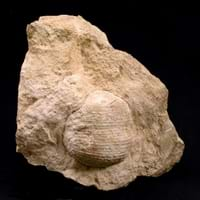Definition
Coquina is a sedimentary rock that is composed either wholly or almost entirely of the transported, abraded, and mechanically-sorted fragments of the shells of molluscs, trilobites, brachiopods, or other invertebrates
Limestone is a sedimentary rock composed mostly of calcite and aragonite, which are different crystal forms of calcium carbonate
Origin
European Foreland Basins
New Zealand
Discoverer
Unknown
Belsazar Hacquet
Etymology
From Concha (Latin)+ Coquina(Spanish) +conch(English)= Couquina (mid 19th century)
From lime and stone in late 14th Century
Class
Sedimentary Rocks
Sedimentary Rocks
Sub-Class
Durable Rock, Soft Rock
Durable Rock, Medium Hardness Rock
Group
Not Applicable
Not Applicable
Other Categories
Coarse Grained Rock, Opaque Rock
Fine Grained Rock, Opaque Rock
Texture
Clastic
Clastic or Non-Clastic
Color
Beige, Buff, Orange
Beige, Black, Blue, Brown, Cream, Gold, Green, Grey, Light Green, Light Grey, Linen, Pink, Red, Rust, Silver, White, Yellow
Durability
Non-Durable
Durable
Appearance
Layered, Banded, Veined and Shiny
Rough and Banded
Interior Uses
Decorative Aggregates, Homes, Hotels, Interior Decoration
Decorative Aggregates, Interior Decoration
Exterior Uses
Garden Decoration, Office Buildings
As Building Stone, As Facing Stone, Garden Decoration, Office Buildings
Other Architectural Uses
Curbing
Curbing
Construction Industry
Building houses or walls, Construction Aggregate
Cement Manufacture, Cobblestones, for Road Aggregate, Production of Glass and Ceramics, Raw material for the manufacture of mortar, Roadstone, Source of calcium
Medical Industry
Not Yet Used
In Chemical and Pharmaceutical Industry, Medicines and Cosmetics
Antiquity Uses
Artifacts, Monuments, Sculpture, Small Figurines
Artifacts, Monuments, Sculpture, Small Figurines
Commercial Uses
Creating Artwork
Animal feed filler, As a Feed Additive for Livestock, Paper Industry, Raw material for manufacture of quicklime, slaked lime, Soil Conditioner, Used in aquariums, Whiting material in toothpaste, paint and paper
Types
Not Available
Chalk, Coquina, Fossiliferous Limestone, Lithographic Limestone, Oolitic Limestone, Travertine, Tufa
Features
Available in Lots of Colors and Patterns, Is one of the oldest rock
Host Rock for Lead, Stalactites and stalagmites are formed from this rock, Zinc and Copper Deposits
Archaeological Significance
Famous Monuments
Data Not Available
Acropolis of Athens in Greece, Agia Sophia in Istanbul, Turkey, Al Aqsa Mosque in Jerusalem, Angkor Wat in Cambodia, Big Ben in London, Charminar in Hyderabad, India, Chhatrapati Shivaji Terminus in Maharashtra, India, Chichen Itza in Mexico, Empire State Building in New York, Khajuraho Temples, India, Kremlin in Moscow, Louvre in Paris, France, Neuschwanstein in Bavaria, Potala Palace in Lahasa, Tibet, Wailing Wall in Jerusalem
Famous Sculptures
Data Not Available
Ajanta Caves in Maharashtra, India, Elephanta Caves in Maharashtra, India
Formation
Coquina is a sedimentary rock which is formed when billions of small clam-like seashell, called Coquina, or cockleshell are die and hence are deposited, buried and turns into a rock when pressure is applied.
Limestone is a sedimentary rock which is mainly made up of calcium carbonate.
Mineral Content
Apatite, Augite, Bronzite, Calcite, Chert, Chlorite, Clay Minerals, Epidote, Feldspar, Garnet, Micas, Muscovite or Illite
Calcite, Chert, Clay, Dolomite, Quartz, Sand, Silt
Compound Content
CaO, Carbon Dioxide, Iron(III) Oxide, MgO
Aluminium Oxide, NaCl, CaO, Iron(III) Oxide, FeO, MgO
Types of Metamorphism
Not Applicable
Not Applicable
Types of Weathering
Biological Weathering, Chemical Weathering, Mechanical Weathering
Biological Weathering, Chemical Weathering, Mechanical Weathering
Types of Erosion
Coastal Erosion, Sea Erosion, Water Erosion, Wind Erosion
Chemical Erosion, Coastal Erosion
Grain Size
Coarse Grained
Fine Grained
Fracture
Irregular
Splintery
Porosity
Highly Porous
Less Porous
Luster
Dull to Vitreous to Submetallic
Dull to Pearly
Compressive Strength
Not Available
Cleavage
Not Available
Non-Existent
Toughness
Not Available
1
Specific Gravity
1.10-2.24
2.3-2.7
Transparency
Opaque
Opaque
Density
2.8-2.9 g/cm3
2.3-2.7 g/cm3
Specific Heat Capacity
Not Available
Resistance
Heat Resistant, Impact Resistant, Pressure Resistant, Wear Resistant
Pressure Resistant
Deposits in Eastern Continents
Asia
Not Yet Found
Brunei, India, Indonesia, Malaysia, Singapore, Thailand, Vietnam
Africa
Not Yet Found
Cameroon, Chad, Ghana, Kenya, Malawi, Sudan, Tanzania, Togo, Zambia, Zimbabwe
Europe
United Kingdom
United Kingdom
Others
Not Yet Found
Not Yet Found
Deposits in Western Continents
South America
Not Yet Found
Colombia
Deposits in Oceania Continent
Australia
Not Yet Found
Adelaide, New Zealand, Queensland, Tonga, Victoria, Yorke Peninsula
Coquina vs Limestone Characteristics
Though some rocks look identical, they have certain characteristics which distinguish them from others. Characteristics of rocks include texture, appearance, color, fracture, streak, hardness etc. Coquina vs Limestone characteristics assist us to distinguish and recognize rocks. Also you can check about Properties of Coquina and Properties of Limestone. Learn more about Coquina vs Limestone in the next section. The interior uses of Coquina include Decorative aggregates, Homes, Hotels and Interior decoration whereas the interior uses of Limestone include Decorative aggregates and Interior decoration. Due to some exceptional properties of Coquina and Limestone, they have various applications in construction industry. The uses of Coquina in construction industry include Building houses or walls, Construction aggregate and that of Limestone include Cement manufacture, Cobblestones, For road aggregate, Production of glass and ceramics, Raw material for the manufacture of mortar, Roadstone, Source of calcium.
More about Coquina and Limestone
Here you can know more about Coquina and Limestone. The life cycle of a rock consists of formation of rock, composition of rock and transformation of rock. The composition of Coquina and Limestone consists of mineral content and compound content. The mineral content of Coquina includes Apatite, Augite, Bronzite, Calcite, Chert, Chlorite, Clay Minerals, Epidote, Feldspar, Garnet, Micas, Muscovite or Illite and mineral content of Limestone includes Calcite, Chert, Clay, Dolomite, Quartz, Sand, Silt. You can also check out the list of all Sedimentary Rocks. When we have to compare Coquina vs Limestone, the texture, color and appearance plays an important role in determining the type of rock. Coquina is available in beige, buff, orange colors whereas, Limestone is available in beige, black, blue, brown, cream, gold, green, grey, light green, light grey, linen, pink, red, rust, silver, white, yellow colors. Appearance of Coquina is Layered, Banded, Veined and Shiny and that of Limestone is Rough and Banded. Properties of rock is another aspect for Coquina vs Limestone. The hardness of Coquina is 1-2 and that of Limestone is 3-4. The types of Coquina are Not Available whereas types of Limestone are Chalk, Coquina, Fossiliferous Limestone, Lithographic Limestone, Oolitic Limestone, Travertine, Tufa. Streak of rock is the color of powder produced when it is dragged across an unweathered surface. The streak of Coquina and Limestone is white. The specific heat capacity of Coquina is Not Available and that of Limestone is 0.91 kJ/Kg K. Depending on the properties like hardness, toughness, specific heat capacity, porosity etc., rocks are resistant to heat, wear, impact, etc.Coquina is heat resistant, impact resistant, pressure resistant, wear resistant whereas Limestone is pressure resistant.





